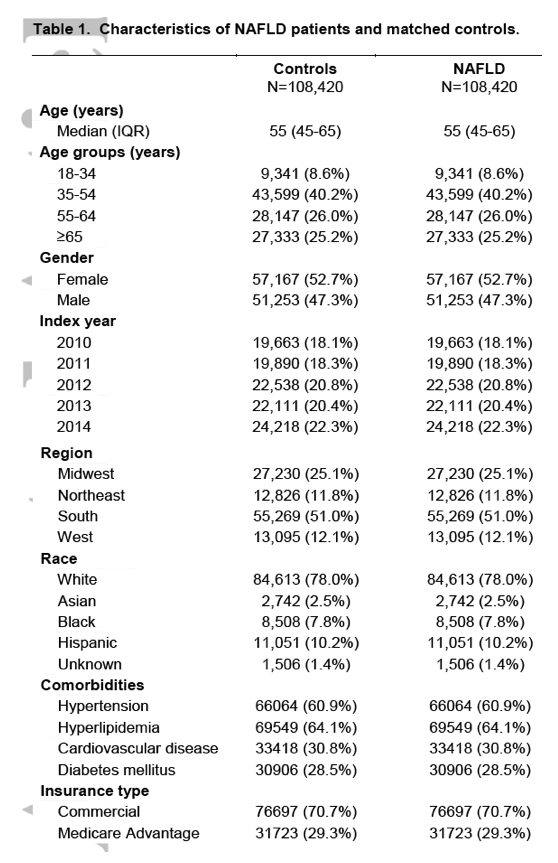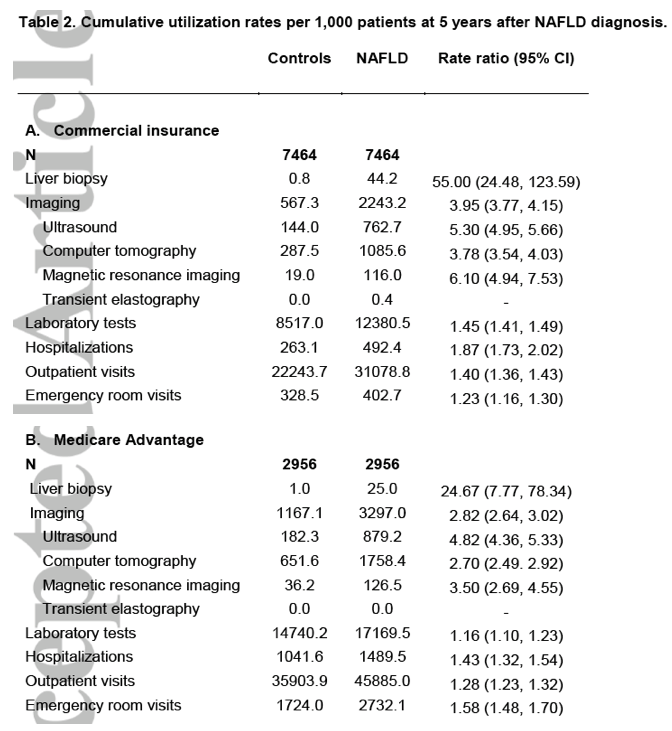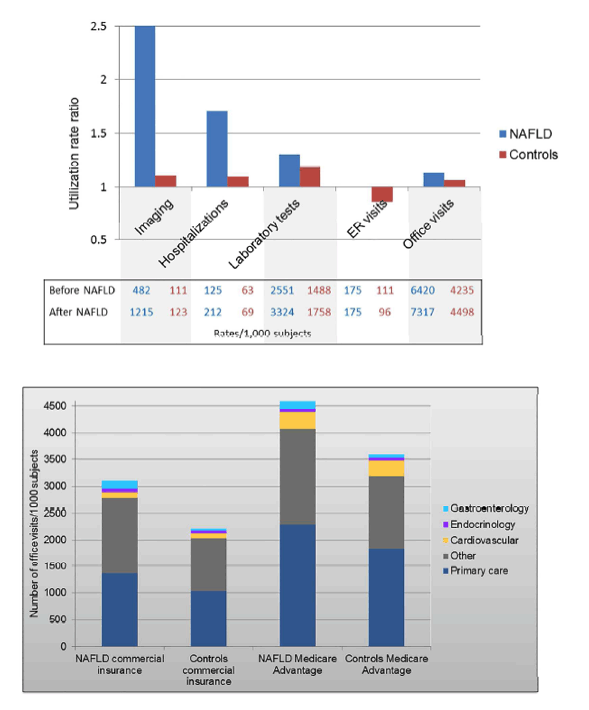 |
 |
 |
| |
Healthcare Cost and Utilization in Nonalcoholic Fatty Liver Disease:
Real-World Data from a Large US Claims Database
|
| |
| |
Download the PDF here
"Using real world data from a large nationwide medical claims database, we show that the long-term cumulative healthcare cost of a NAFLD patient is 80% higher than that of a non-NAFLD control of similar age and metabolic comorbidities.....The disease characteristics and the enormous clinical burden of NAFLD pose considerable challenges to the medical community, which extend beyond the hepatology field......Nonalcoholic fatty liver disease (NAFLD) is the most common chronic liver disease in the Western countries, affecting 24%(1) to 45%(2) of the United States (US) population or 64-100 million people. Most (approximately 80%) patients with NAFLD have hepatic steatosis without inflammation, which is associated with a relatively low risk of fibrosis(3, 4) but does have strong correlation with cardiovascular disease, metabolic complications(5), and increased mortality compared to the general population(6). The remaining 20% of patients have nonalcoholic steatohepatitis (NASH), which leads to cirrhosis, hepatocellular carcinoma, and other liver related complications(7).......Given the increasing prevalence of NAFLD, the economic burden is undoubtedly considerable, but real-world data are scarce. US healthcare expenditures have steadily increased over the last decades and are projected to account for 20% of the economy by 2024(8, 9). The NAFLD epidemic wave could hasten this increase; therefore, assessment of its contribution to the economic burden and the major healthcare utilization drivers is imperative"
-------------------------------
Hepatology June 2018 - Alina M. Allen, MD1, Holly K. Van Houten, BA2,3, Lindsey R. Sangaralingham, MPH2,3, Jayant A. Talwalkar, MD MPH1,2, Rozalina G. McCoy, MD MS2,4,5
1 Division of Gastroenterology and Hepatology
2 Robert D. and Patricia E. Kern Center
for the Science of Health Care Delivery, Mayo Clinic, Rochester, MN and 3OptumLabs,
Cambridge, MA
4Division of
Primary Care Internal Medicine, Department of Medicine, Mayo Clinic, Rochester, MN and
5Division of Health Care Policy & Research, Department of Health Sciences Research, Mayo
Clinic, Rochester, MN
Abstract
The prevalence of nonalcoholic fatty liver disease (NAFLD) is increasing. The health care burden resulting from the multidisciplinary management of this complex disease is unknown. We assessed the total health care cost and resource utilization associated with a new NAFLD diagnosis, compared to controls with similar comorbidities. We used OptumLabs Data Warehouse, a large national administrative claims database with longitudinal health data of over 100 million individuals enrolled in private and Medicare Advantage health plans. We identified 152,064 adults with a first claim for NAFLD between 2010-2014, of which 108,420 were matched 1:1 by age, sex, metabolic comorbidities, length of follow-up, year of diagnosis, race, geographic region and insurance type to non-NAFLD contemporary controls from the OLDW database. Median follow-up time was 2.6 (range 1-6.5) years. The final study cohort consisted of 216,840 people with median age 55 (range 18-86) years, 53% female, 78% white.
The total annual cost of care per NAFLD patient with private insurance was $7,804 (IQR $3,068-$18,688) for a new diagnosis and $3,789 (IQR $1,176-$10,539) for long-term management. These costs are significantly higher than the total annual costs of $2,298 (IQR $681-$6,580) per matched control with similar metabolic comorbidities but without NAFLD. The largest increases in healthcare utilization which may account for the increased costs in NAFLD compared to controls are represented by liver biopsies (RR=55.00, 95% CI 24.48-123.59), imaging (RR=3.95, 95% CI 3.77-4.15) and hospitalizations (RR=1.87, 95%CI 1.73-2.02).
Conclusions: The costs associated with the care for NAFLD independent of its metabolic comorbidities are very high, especially at first diagnosis. Research efforts should focus on identification of underlying determinants of use, sources of excess cost and development of cost-effective diagnostic tests.
The costs were highest during the first year following the index NAFLD diagnosis, likely reflecting the costs of diagnosis and initial evaluation for NAFLD and its comorbidities. Specifically, among patients with commercial insurance the median cost of medical care during the year following NAFLD diagnosis increased by 72%, from $4,547 (IQR $1,648-$11,661) to $7,804 (IQR $3,068-$18,688). The median costs for Medicare Advantage enrollees with NAFLD increased by 38%, from $6,566 (IQR $3139-$14,787) during the year prior to NAFLD diagnosis to $9,062 (IQR $4,313-$20,765) during the year after diagnosis. For reference, the annual healthcare costs of non-NAFLD matched controls increased only by 5-10% after the index date, in line with the expected increase in annual rates.
The annual healthcare costs in the subsequent years were lower than the immediate peri-diagnosis period. Nevertheless, the annual costs for NAFLD patients remained considerably higher than those for matched controls. Specifically, at 5 years after NAFLD diagnosis, the median annual healthcare cost was $3,789 (IQR $1,176-$10,539) per NAFLD patient with commercial insurance and $2,298 (IQR $681-$6,580) per control. Among the Medicare Advantage population, the median annual healthcare cost was $5,363 (IQR $2,402-$12,515) per NAFLD patient and $4,111 (IQR $1,677-$9,958) per control.
Consequently, the median cumulative healthcare costs 5 years following the index NAFLD diagnosis for an individual with commercial insurance were nearly 80% higher than a control with similar age and comorbidities: $30,994 (IQR $14,688- $64,972) versus $17,345 (IQR $7,198-$38,713). The median cumulative 5-year costs for a NAFLD individual with Medicare Advantage were 42% higher than controls: $39,588 (IQR $20,950-$71,226) versus $27,777 (IQR $14,192-$54,666).
The largest increase in utilization (rate/1,000 patients) after NAFLD diagnosis was liver biopsy from 5.5 to 28.8, followed by liver related imaging and all-cause hospitalizations. There were smaller, but consistent, increases in laboratory testing episodes, ED visits and office visits. Figure 2A demonstrates the relative change in utilization rates among commercially insured patients with NAFLD when compared to controls. Patients with NAFLD experienced substantial increases in utilization of imaging (RR=2.52, 95%CI 2.49-2.56), hospitalizations (RR=1.69, 95%CI 1.64-1.75) and laboratory tests (RR=1.30, 95%CI 1.29-1.32) when compared to controls, in whom the relative increases were minimal. Among the most commonly used imaging modalities, MRI use showed the highest increase after diagnosis (RR=3.42, 95%CI 3.20-3.66), followed by ultrasound (RR=2.77, 95%CI 2.71-2.82) and CT (RR=2.57, 95%CI 2.52-2.62) (eTable 5).
Using real world data from a large nationwide medical claims database, we show that the long-term cumulative healthcare cost of a NAFLD patient is 80% higher than that of a non-NAFLD control of similar age and metabolic comorbidities. The highest annual costs occur around a new diagnosis of NAFLD, reaching $7,804 and $9,062 per individual with private insurance and Medicare Advantage, respectively. Annual costs for long-term management decrease to $3,789 and $5,363 per individual with private insurance and Medicare Advantage, respectively, but remain considerably higher than controls. The largest increases in healthcare utilization which may account for the increased costs in NAFLD are represented by liver biopsies, imaging and hospitalizations. The large burden of NAFLD is managed predominantly by primary care physicians, while subspecialty visits in gastroenterology represent only 3-4.6% of the total office visits. These data highlight that, as the NAFLD burden will continue to increase(18), solutions are needed to promote innovative health care delivery platforms to reduce costs and to provide primary care physicians with the necessary strategies and resources to optimally manage this complex patient population.
The disease characteristics and the enormous clinical burden of NAFLD pose considerable challenges to the medical community, which extend beyond the hepatology field.
In this cohort, a strikingly low proportion of the outpatient visits were represented by gastroenterology and hepatology. The overwhelming clinical burden of NAFLD is supported by general practitioners, who have a key role in the identification, risk stratification and timely referral for specialty care in NAFLD, but may be unfamiliar with the intricacies of the disease(19).



|
| |
|
 |
 |
|
|